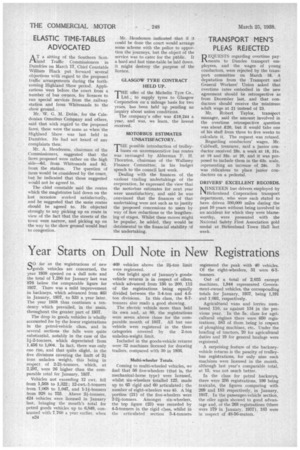Year Starts on Dull Note in New Registrations
Page 58

If you've noticed an error in this article please click here to report it so we can fix it.
CO far as the registrations of new P./goods vehicles are concerned, the year 1938 opened on a dull note and the total of 7,256 for January last was 876 below the comparable figure for 1937. There was a mild improvement in hackneys, which advanced from 463 in January, 1937, to 533 a year later. The year 1938 thus continues a tendency which prevailed, in the main, throughout the greater part of 1937.
The drop in goods vehicles is wholly accounted for by the lower registrations in the petrol-vehicle class, and in several sections the falls were quite substantial, notably in the case of the 1i-2-tonners, which depreciated from 1,456 to 1,004. In fact, there was only one rise, and that quite slight, in the five divisions covering the limit of 24 tons unladen weight, this being in respect of 2-24-tonners, which, at 2,297, were 26 higher than the comparable total for January, 1937.
Vehicles not exceeding 12 cwt. fell from 1,568 to 1,322; 12-cwt.-1-tonners from 1,068 to 1,047, and 1-14-tonners from 928 to 755. Above 24-tonners, 424 vehicles were licensed in January last, bringing the month's total for petrol goods vehicles up to 6,849, contrasted with 7,760 a year earlier, when a24 469 vehicles above the 24-ton limit were registered.
One bright spot of January's goodsvehicle returns is in respect of oilers, which advanced from 156 to 200, 112 of the registrations being equally divided between the 3-4-ton and 4-5ton divisions. In this class, the 6-7tonners also made a good showing.
The electric vehicle more than held its own and, at 80, the registrations were seven above those for the comparable month of 1937. All but one vehicle were registered in the three categories covered by the 2-ton unladen-weight limit.
Included in the goods-vehicle returns were 32 machines licensed for drawing trailers, compared with 30 in 1936.
_Multi-wheeler Totals.
Coming to multi-wheeled vehicles, we find that 56 five-wheelers (that is, the mechanical-horse type) were licensed. whilst six-wheelers totalled 125, made up to 65 rigid and 60 articulated ; the number of eight-wheelers was 45. A big portion (21) of the five-wheelers were 2-24-tonners. Amongst six-wheelers, the top figure (23) was recorded by 4-5-tonners in the rigid class, whilst in the articulated section 3-4-tonners registered the peak with 40 vehicles. Of the eight-wheelers, 31 were 6-7tonners.
Out of a total of 2,035 exempt machines, 1,944 represented Government-owned vehicles, the corresponding totals for January, 1937, being 1,191 and 1,093, respectively.
Agricultural vans and lorries numbered 110, as against 134 in the previous year. In the 5s. class for agricultural engines there were 650 registrations, 583 of them being in respect of ploughing machines, etc. Under the heading of tractors, 20 for agricultural duties and 10 for general haulage were registered.
A surprising feature of the hackneyvehicle returns is the paucity of trolleybus registrations, for only nine such machines were licensed in the month, although last year's comparable total, at 15, was not much better.
In the class for petrol hackney. there were 256 registrations, 199 being taxicabs, the figures comparing with 269 and 183 respectively, in January, 1937. In the passenger-vehicle section, the oiler again showed to good advantage and, of the 268 registrations (there were 179 in January, 1937), 183 were in respect of 48-56-seaters.




























































































